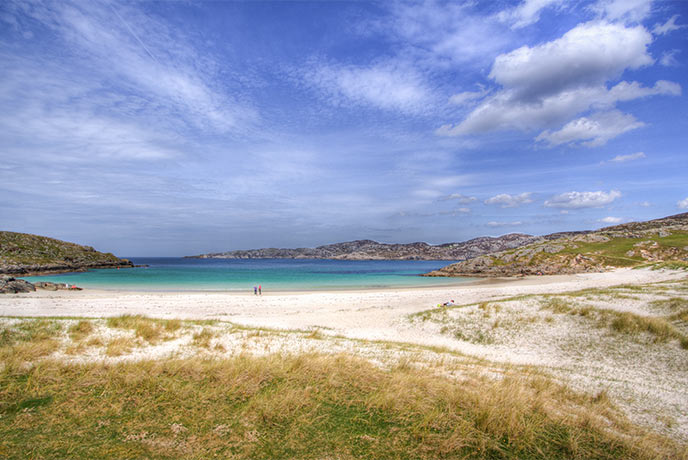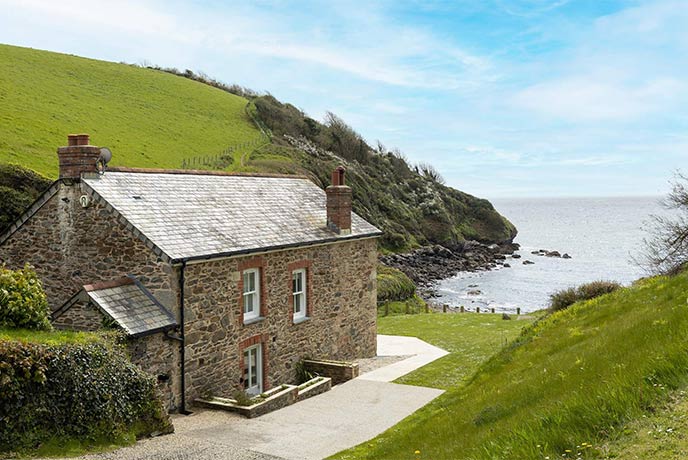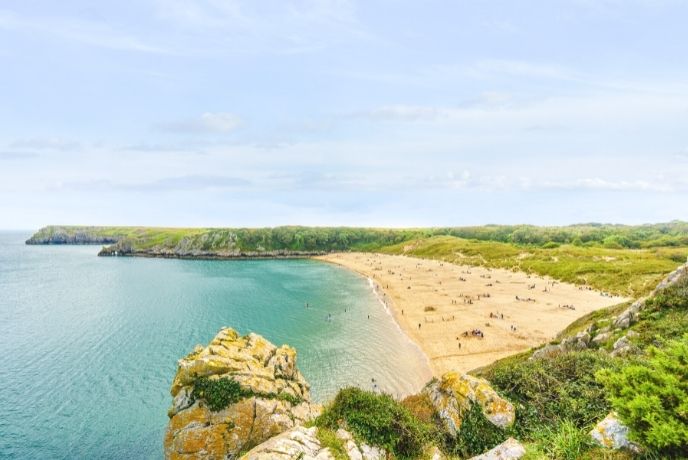World-renowned for its award-winning beaches, clear waters, and castle-clad cliffs, Pembrokeshire Coast National Park is an untouched haven for both wildlife and outdoor enthusiasts. Whether you’re looking to enjoy its 186-mile coastal path, relaxed fishing towns, ancient history or rare flora and fauna, this quiet corner is unlike anywhere else in Britain.
Britain’s only coastal national park, Pembrokeshire has a deep-seated connection to the sea. Drawing nature lovers from around the globe, its coastal scenery provides the perfect backdrop for days spent walking, climbing, surfing and sampling delicious seafood.
With more Blue Flag beaches than any other county, and more Green Coast Award hidden gem beaches than anywhere else in Wales, Pembrokeshire is a place where nature takes centre stage. You won’t find big towns or built-up areas. Instead, you’ll discover endless scenery, friendly coastal communities, and a slower pace of life, leading to its designation by National Geographic as the second-best coastal destination in the world.
About Pembrokeshire Coast National Park
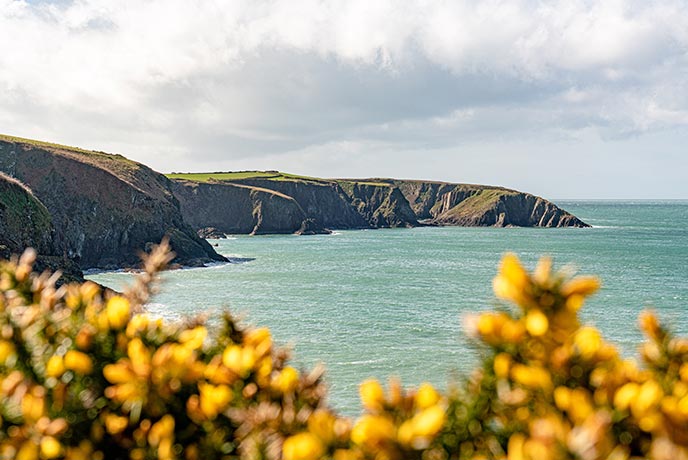
The Pembrokeshire Coast National Park is one of the UK’s smallest National Parks, covering an area of 236 square miles. However, what it lacks in size, it makes up for in beauty. Its unusual shape, which traces the seaward edge of the Pembrokeshire county, means you are never more than 10 miles from the ocean.
Pembrokeshire’s windswept and wondrous landscapes have long inspired creatives. Artists like Graham Sutherland, John Piper, and John Knapp-Fisher famously captured Pembrokeshire’s remote wilderness through their prints and paintings, while literary greats including Mary Shelley, Roald Dahl, and Beatrix Potter all have ties to the area.
Today, Pembrokeshire has plenty to offer, with its snug coastal pubs, picture-postcard villages, and internationally important bird colonies attracting visitors from around the globe. For adventure seekers, the coastline also promises thrilling coasteering, caving, and surfing opportunities.
Landscape

Stretching from St Dogmaels in the north to Amroth in the south, the Pembrokeshire coastline has captivated geologists for centuries. Its diverse rock formations were key to its National Park status, with around 40% of the coast also designated as Sites of Special Scientific Interest (SSSIs).
In the south, majestic limestone cliffs and vast sandy bays define the landscape around Tenby, Amroth, and Freshwater West, while the wooded reaches of the Daugleddau Estuary provide a lesser-known Marine Special Area of Conservation. On the western coast, mighty headlands protrude into the Atlantic, with weather-worn cliffs and offshore islands providing sanctuary for coastal birds and grey seal colonies.
Further north, wide bays give way to secret coves and flooded glacial valleys. Just inland, the acidic grasslands, moorland, and heath of the Preseli Hills offer a striking contrast – a habitat for rare orchids and marsh fritillary butterflies that was once crossed by ancient travellers heading to and from Ireland. The best way to experience it all is on foot, with the 186-mile Pembrokeshire Coast Path revealing every crinkle and crease of this unforgettable peninsula.
Wildlife

The Pembrokeshire coastline is a haven for breeding seabirds, particularly its offshore islands: Ramsey, Skomer, Grassholm, Skokholm, and Caldey. Skomer is home to the largest colony of puffins in south Britain, over 50% of the world’s population of Manx shearwaters can be found on Skokholm, and Grassholm attracts the third-largest colony in the world of breeding gannets. You’ll also spot storm-petrels, guillemots, and razorbills resting in the Pembrokeshire cliffs – and Skomer is the only place you’ll find the endangered Skomer vole, a tiny rodent endemic to the island. On the slightly larger scale, Welsh mountain ponies also roam free along the coast, making for an adorable subject when photographing the landscapes.
Below the cliffs, Pembrokeshire’s waters are teeming with wildlife. It’s a known breeding ground for Atlantic grey seals, which haul out with their young during the autumn and winter months for pupping season. During the summer, you may glimpse bottlenose, common, and Risso’s dolphins dancing in the waves, especially in the Cardigan Bay area. Pembrokeshire also attracts a number of migratory species, with rare sightings of orca, humpbacks, and giant Atlantic bluefin tuna amongst the highlights of the wildlife calendar.
Beaches in Pembrokeshire Coast National Park
With hundreds of miles of coastline, the Pembrokeshire Coast National Parkspending boasts a myriad of beautiful beaches to uncover during your visit.
Barafundle Bay
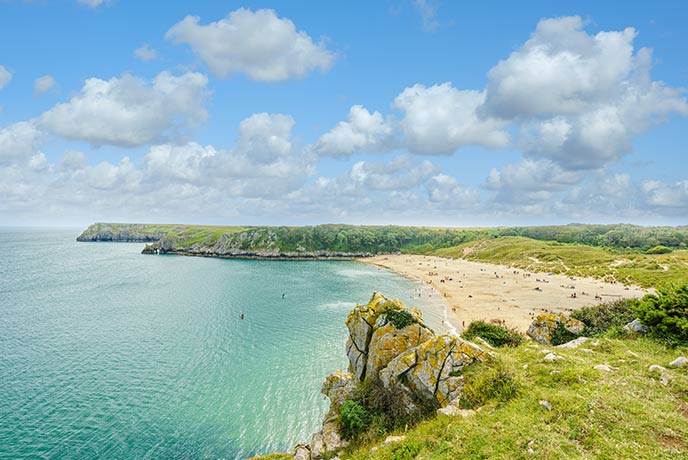
The jewel in the crown of Pembrokeshire’s beaches, dog-friendly Barafundle Bay is recognised as one of the most beautiful in the world because of its pristine sand and clear waters. Protected by pine-covered headlands and backed by soft dunes, it has a wonderfully secluded feel. In reality, Barafundle is just a short walk through bluebell woodland and across a field from the National Trust car park at Stackpole Quay.
Whitesands

Discover perfect white sand and turquoise waters at one of Pembrokeshire’s most cherished beaches. Its western aspect also means it picks up swell, making it popular with surfers. Visitors can enjoy spectacular views out to Ramsey Island and St Davids Head. A Blue Flag beach, Whitesands has plenty of amenities including public toilets, a café, and easy access.
Marloes Sands
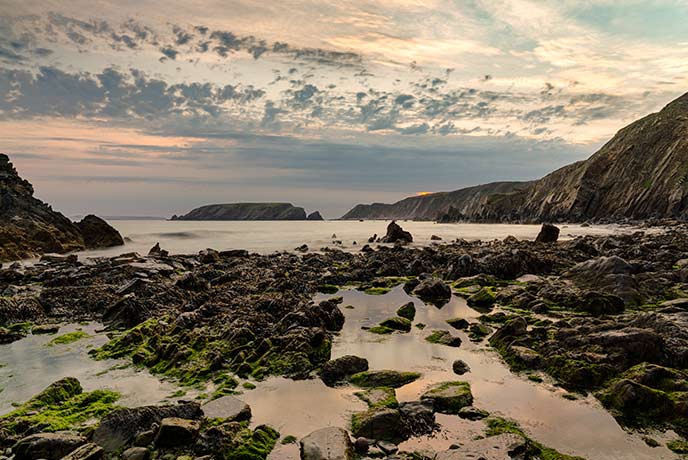
A hit with nature lovers and geologists, Marloes Sands is surrounded by windswept cliffs with its southern side carved from sedimentary sandstone. A known sanctuary for seabirds, there’s also a good chance of spotting grey seals from the top of the cliffs. Accessible by foot, with the nearest car park half a mile away, it’s a remote option perfect for tying in with a coastal walk and a picnic.
Freshwater West

An inviting strip of golden sand, Freshwater West is a surfer's paradise. It’s also known for its spectacular sunsets during the spring, autumn, and summer. To the rear of the beach are the Broomhill Burrows, an extensive dune system that featured in Harry Potter and the Deathly Hallows as the backdrop for Dobby’s Shell Cottage. The beach itself is also a famous filming location, providing an epic backdrop for Russel Crowe’s Robin Hood epic.
Aberfforest Beach
Accessed via the coastal path, Aberfforest Beach lies between Newport and Dinas. It’s a quiet spot, well-sheltered by headlands on either side and backed by only a handful of houses. The greenery of the cliffs reflects onto the water, with a pretty woodland concealing one of Pembrokeshire’s largest waterfalls at the back of the beach, making for an idyllic setting.
Tenby North
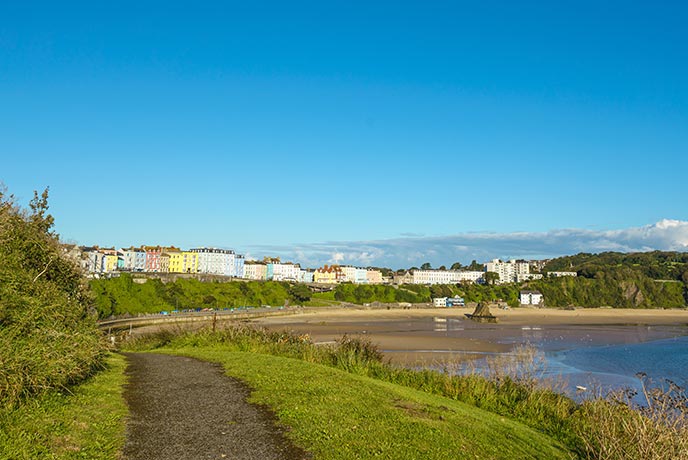
Tenby boasts four beaches, but Tenby North is where you’re able to catch the sun all day. Its enclosed easterly position also makes it well-sheltered in most weather and perfect for swimming. Enjoy sea views towards Gaskar Rock, St Catherine’s Island, and Carmarthen Bay. It’s a lifeguarded, family-friendly option with easy access to cafés, shopping, and restaurants in the town.
Towns and villages in Pembrokeshire Coast National Park
Surrounded by the ocean on three sides, the Pembrokeshire Coast National Park is home to a quaint collection of pretty market towns and coastal villages.
Newport
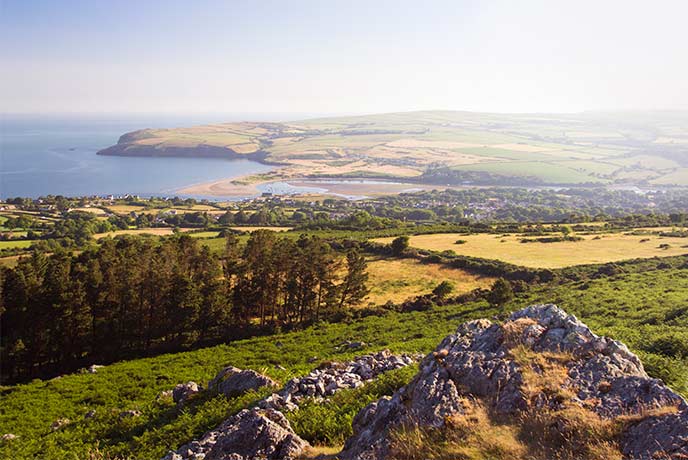
On Pembrokeshire’s north coast, Newport charms visitors with its sandy beach, scenic mountain backdrop, and broad range of eateries. A former herring port overlooked by a Norman castle, it’s also rich in history. You can visit the UK’s oldest medieval kiln and a treasure trove of antiques and artwork at the Carningli Centre.
Fishguard
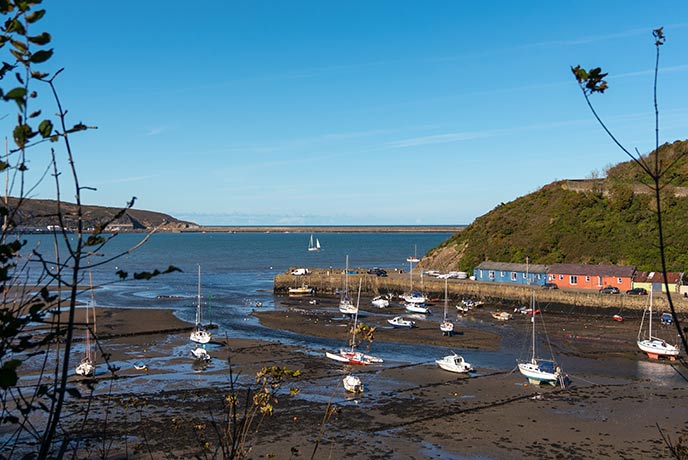
A fantastic base for outdoor enthusiasts, Fishguard is sandwiched between the wild uplands of the Preseli Hills and the scenic panoramas of the Pembrokeshire coast, offering endless walking trails and opportunities for watersports. It’s also a creative hub, home to galleries, indie shops, and a weekly market. Plus a great selection of pubs, cafés, and restaurants.
St Davids
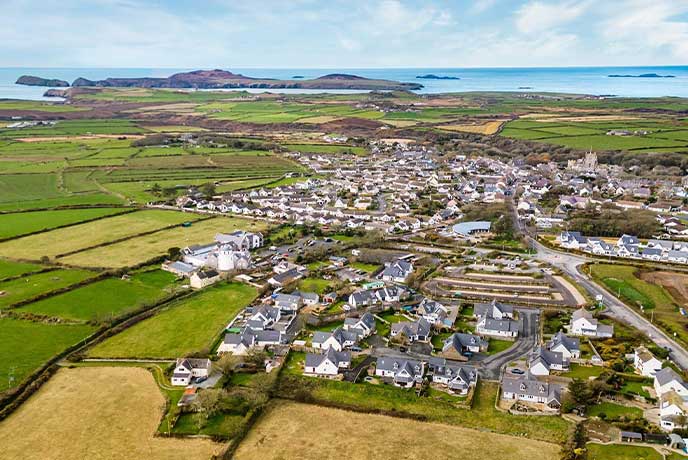
Britain’s smallest city, St Davids, may have fewer than 2,000 residents, but it certainly packs a punch. It’s best known for its magnificent 12th-century cathedral and the romantic ruins of the medieval Bishop’s Palace. Beyond the history, you’ll find boutique shops, charming cafés, welcoming pubs and oodles of character.
St Brides
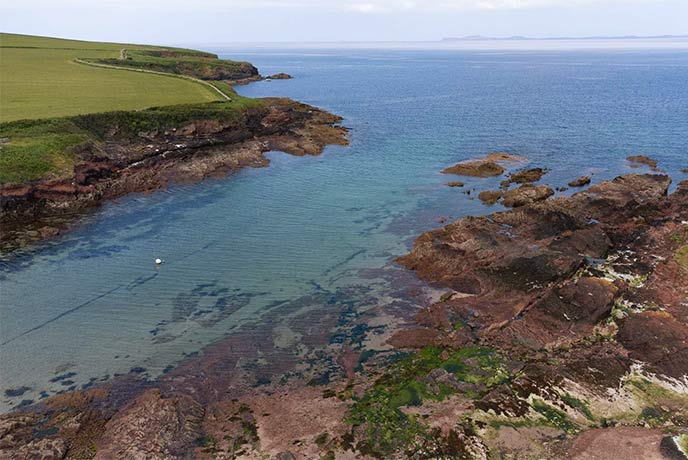
For a peaceful escape, St Brides is a small, unspoilt village with an idyllic sheltered cove. It’s perched on the edge of the Pembrokeshire Coastal Path and close to the departure point for wildlife boat trips to Skomer Island.
Dale
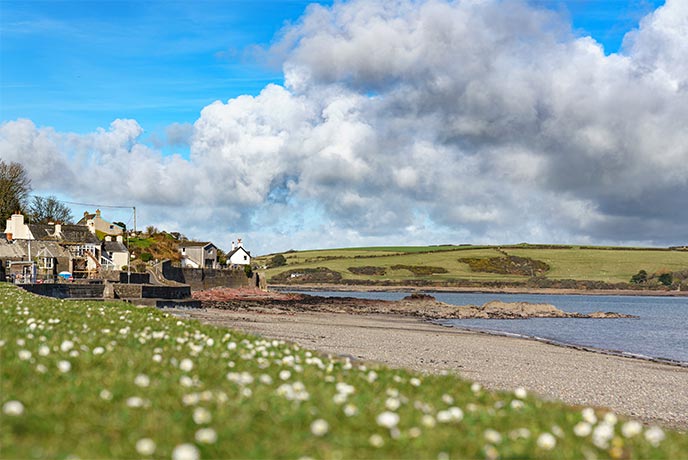
Appealing to watersports enthusiasts, Dale’s sheltered position at the mouth of the Milford Haven Waterway makes it a hit with sailors, swimmers, kayakers and windsurfers. It has a great pub, The Griffin Inn, and plenty of opportunities for offshore boat trips and exploring the Pembrokeshire Coast Path. Not to mention, it holds a reputation for being the sunniest spot in Wales!
Tenby
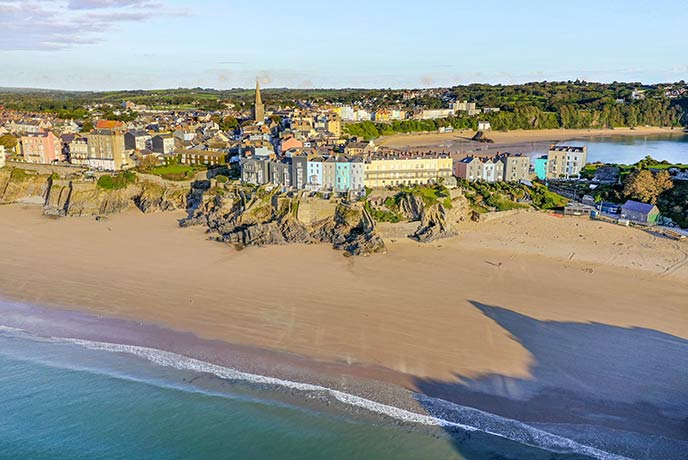
One of Pembrokeshire’s most famous towns, Tenby is easily recognised by its pretty pastel-coloured houses, which slope down to the water. A favourite of Beatrix Potter and Roald Dahl, it’s perfect for seaside strolls, boat trips to Caldey Island, and feasting on freshly-caught fish and fluffy chips overlooking the harbour.
Things to do in Pembrokeshire Coast National Park
Beyond hiking the coastal path, there are plenty more activities to discover throughout Pembrokeshire Coast National Park, from Neolithic ruins to ancient castles and fun-filled days out.
St Davids Cathedral
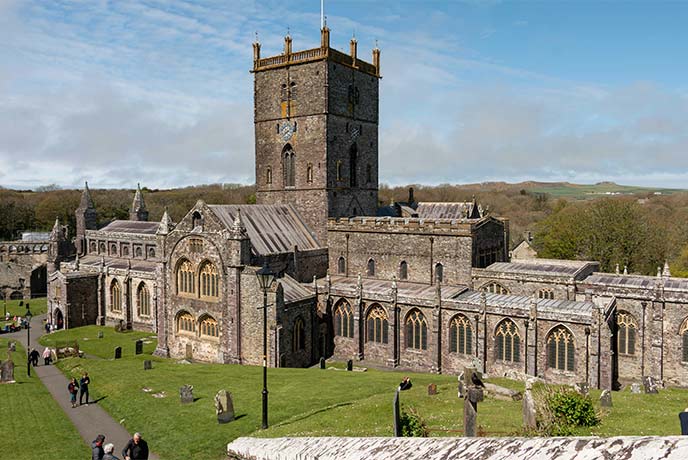
A site of pilgrimage since the 12th century, St Davids Cathedral still attracts hundreds of thousands of visitors each year. Unsurprising, given its immaculately preserved architecture and luxurious interior.
Bishops Palace
A crumbling medieval palace that once rivalled the cathedral in its magnificence, what remains of the Bishops Palace still stands as an extraordinary example of Gothic architecture.
Pentre Ifan
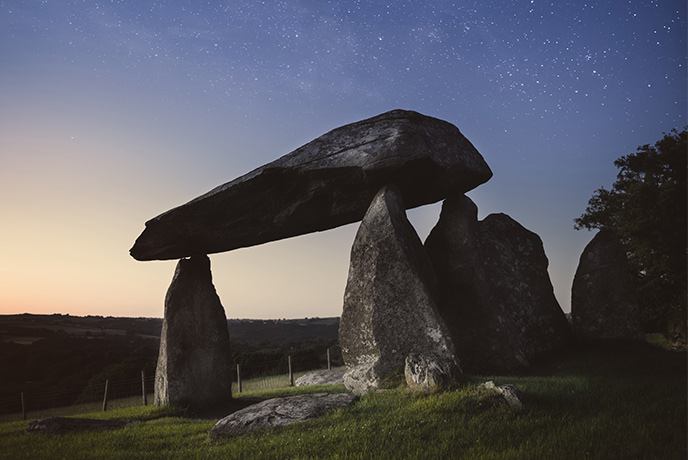
Just outside of Newport, Pentre Ifan is amongst Wales' most famous Neolithic monuments. The chambered tomb, which would have once been encapsulated in a mound of mud, is thought to be around 5,000 years old and promises a fascinating glimpse into the area’s past.
Carew Castle

Pembrokeshire is home to a number of fascinating castles, but there’s one in particular that never fails to drop a jaw or two. Spanning over 2,000 years of history, Carew Castle is great for families, with stunning scenery and a restored tidal mill. A visit takes you through various chapters of history, from its origins as a Norman Keep to its expansion in the Elizabethan era and its role in the Civil War.
Skomer Island

Take a boat trip to Skomer and Pembrokeshire’s offshore isles to visit one of Britain’s most important seabird colonies. Spot puffins up close and witness hurricanes of diving gannets, all while soaking up the beautiful and oh-so-dramatic views.
Outdoor activities
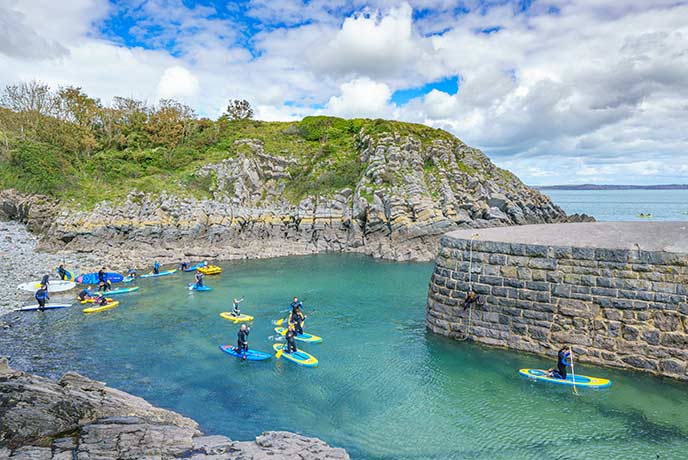
Combine a boat trip to Ramsey Island with an adrenaline-fuelled coasteering adventure. Thought to be the birthplace of coasteering, the Pembrokeshire coast is full of sea caves to explore and epic jump spots to get your heart racing. Stackpole Head is a famous spot for climbing, while the surrounding coastline can be explored from the sea with a fun-filled stand-up paddleboard experience. Whatever your adrenaline-fuelled fancy, Pembrokeshire Coast National Park has a day out for you.
Birdwatching
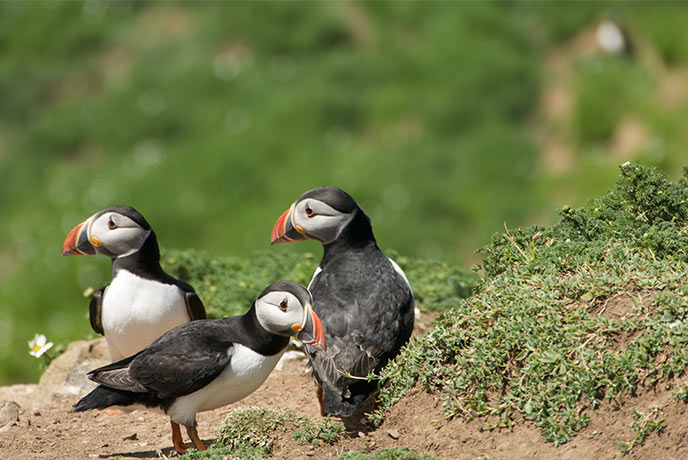
Grab your binoculars and head for the coast, where you can spot some of Britain’s most spectacular seabirds in their natural habitat – from puffins and razorbills to choughs and peregrine falcons soaring along the cliffs.
Walks in Pembrokeshire Coast National Park
Whether the coast calls your name or you fancy the dappled shade of an ancient woodland, the Pembrokeshire Coast National Park is full to the brim with amazing walks - 600 miles of them, to be precise!
Strumble Head

Home to an iconic lighthouse and jaw-dropping panoramic views, Strumble Head is a rather special spot for a coastal excursion. If you’re looking for a bit of a challenge, there’s an 11km circular route here that takes in all the best parts of this dramatic headland, from the lovely coves around Pen Globo to the ancient, Iron Age hill fort of Garn Fawr.
Castell Henllys
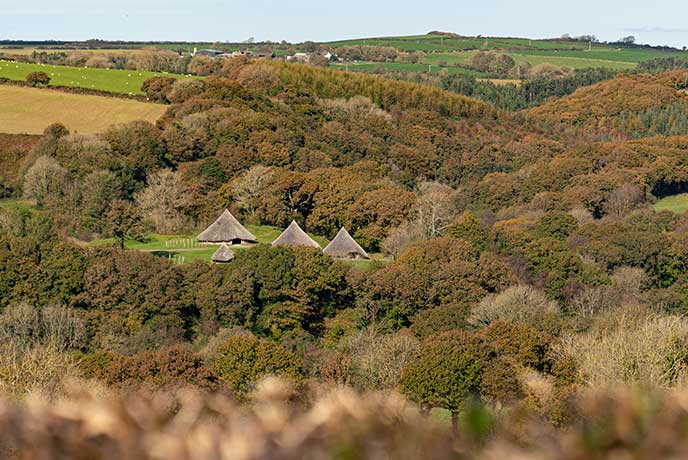
One of Pembrokeshire Coast National Park’s most famous Iron Age settlements, Castell Henllys is a fascinating village that dates back around 2,000 years. The site is dog-friendly and home to some lovely trails, including the intriguing Barefoot Trail, which encourages you to kick off your boots so as to reconnect with the ground beneath you. There’s an onsite café for a post-stroll coffee, and the roundhouses are always worth a visit.
Preseli Hills
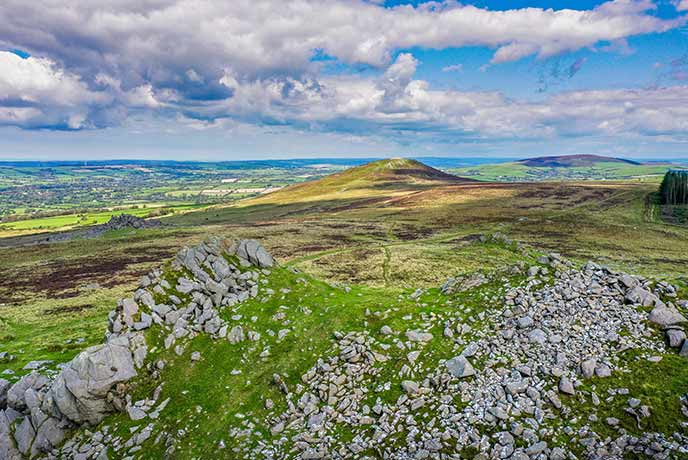
Arching above Pembrokeshire’s sprawling coastline, the Preseli Hills (otherwise known as the Preseli Mountains) are a stunning mountain range that promises a winding collection of walks to explore. The Golden Road is a particularly famous route, covering 8 miles of ancient tracks that have been used by travellers for over 5,000 years.
Pwllgwaelod to Cwm-yr-Eglwys
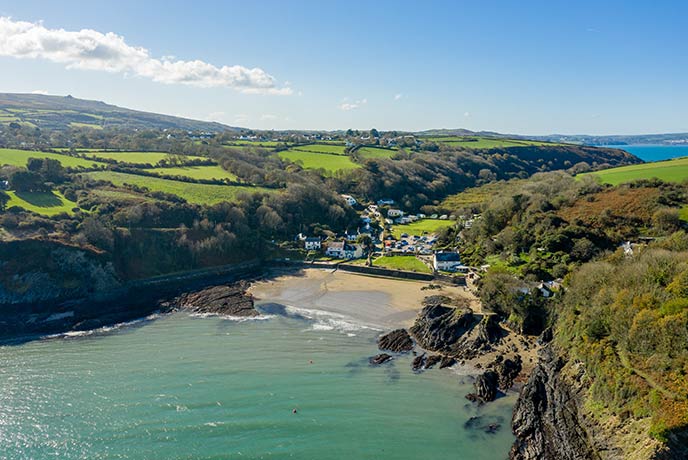
Although the Pembrokeshire Coast National Park boasts many walks that challenge the calves, there are also lots of lovely flat trails that provide access for all. One of our favourites, the dappled route between Pwllgwaelod and Cwm-yr-Eglwys promises tarmaced paths and lovely views at each end. Notable landmarks include the ruins of the Cwm-yr-Eglwys church and the beautiful wooded valley you’ll pass through.
Pubs and places to eat in Pembrokeshire Coast National Park
From cosy pubs and standout restaurants to coastal cafés and farm shops, these Pembrokeshire eateries are just the ticket when you’re ready to refuel.
Sailors’ Safety, Pwllgwaelod

An old smuggler's pub with oodles of heart, Sailors’ Safety is a wonderful blend of sea views and seafood. Nab a table outside to soak up the beautiful coastal setting in Pwllgwaelod, or dip inside for cosy vibes and hearty fare, from burgers to soul-warming fish and shellfish stew. You’ll also find a well-stocked bar that serves up everything from Pimms to local ales.
The Golden Lion, Newport
Found in the centre of Newport, the Golden Lion is a popular stop off for those hiking the Pembrokeshire Coast Path and has been serving visitors and locals since the 1600s when it was a coach house. Today, you can expect a popular gastropub serving food from its restaurant and bar, plus regular live music and an extensive garden area. It’s also renowned for its epic Sunday lunches, the perfect end to a coastal stomp.
The Really Wild Emporium, St Davids
For a taste of the finest local produce, Really Wild Emporium sources its menu from local producers or from foraging the Welsh coast. Food is served all day, but the highlight is the evening’s six-course tasting menu, which can also be tailored to veggie taste buds. Expect a characterful, non-pretentious setting with original stained glass windows, quirky lighting, and exposed wooden floors.
The Old Point House, Angle
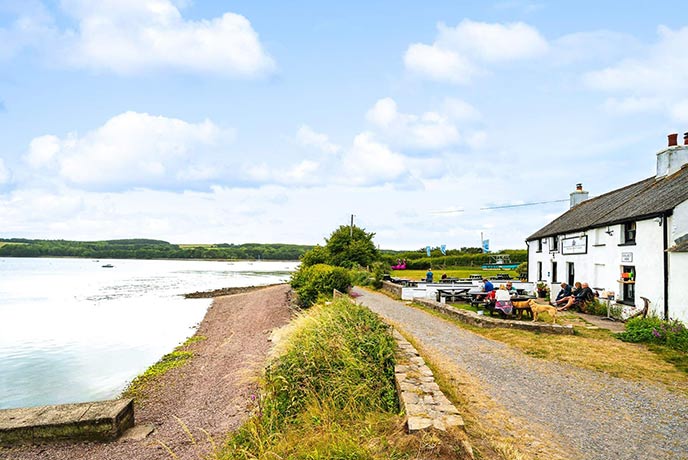
Perched right on the water’s edge in the pretty village of Angle, The Old Point House invites you to dine in style while enjoying glorious beachfront views. With such a close connection to the surrounding coast, it’s of little surprise that the menu is a celebration of all things seafood, including a salt-kissed obsession with seaweed we love to see. Dine in the alfresco seating area, inside for cosy vibes, or pop along to Café Mor for a beach café experience like no other. Seriously, it’s a mobile, solar-powered seaweed café, need we say more?
Runwayskiln, Marloes Sands
Overlooking the beach at Marloes Sands, Runwayskiln is a coastal kitchen serving freshly prepared produce. Grab a breakfast bap from their casual counter, or feast on seasonally inspired dishes in their cute café for lunch. They’re also known for their delicious freshly baked cakes, excellent coffee, and decent veggie options.
The Griffin, Dale
An award-winning waterfront pub overlooking the mouth of the Milford Haven Waterway, The Griffin is a long-standing favourite that’s been delighting diners for over 300 years. Specialising in honest, locally-caught seafood, its menu features favourites like lobster, gurnard, and scallops. Floor-to-ceiling glass windows create a further connection to the ocean, making it a memorable stop in any season.
Ready to explore the UK’s most unique National Park? Browse our collection of holiday cottages in Pembrokeshire and prepare for a one-of-a-kind stay in this captivating corner.


